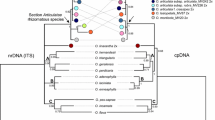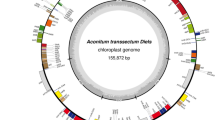Abstract
Internal transcribed spacer (ITS) sequences of nuclear ribosomal DNA (nrDNA) were used to examine the phylogeny of East Asian aconites. Individual aconites were discovered to contain as many as eight different ITS sequences after cloning and PCR-SSCP (single-stranded conformational polymorphisms) analysis. We identified eight putative ITS pseudogenes from four taxa with low predicted secondary structure stability and high substitution rates. Maximum likelihood (ML) and neighbor-joining (NJ) methods were used for phylogenetic reconstruction. The ITS trees agree with the previous chloroplast DNA (cpDNA) tree for the vast majority of the taxa. We found two East Asian clades in the ITS trees: 1) a clade with the Chinese diploid,Aconitum volubile and East Asian tetraploids, and 2) a clade of East Asian diploids and Siberian tetraploids. In the former clade, most tetraploid taxa appear to be polyphyletic; sequences from individual plants did not correspond to recognized taxonomic units. This indicates a recent divergence of the East Asian tetraploids.
Similar content being viewed by others

References
Adachi J., Hasegawa M. (1996) MOLPHY, programs for molecular phylogenetics, version 2.3. Institute of Statistical Mathematics, Tokyo.
Abramson R. D. (1995) Thermostable DNA polymerases. In: Innis M. A., Gelfand D. H., Sninsky J. J. (eds.) PCR Strategies. Academic Press, San Diego, pp. 39–57.
Bailey A. L. (1995) Single-stranded conformational polymorphisms. In: Innis M. A., Gelfand D. H., Sninsky J. J. (eds.) PCR Strategies. Academic Press, San Diego, pp. 121–129.
Baldwin B. G. (1992) Phylogenetic utility of the internal transcribed spacers of nuclear ribosomal DNA in Plants: an example from the Compositae. Molec. Phylogenetics Evol. 1: 3–16.
Baldwin B. G., Sanderson M. J., Porter J. M., Wojciechowski M. F., Campbell C. S., Donoghue M. J. (1995) The ITS region of nuclear ribosomal DNA: a valuable source of evidence on Angiosperm phylogeny. Ann. Missouri Bot. Gard. 82: 247–277.
Buckler E. S., Holtsford T. P. (1996a)Zea systematics: ribosomal ITS evidence. Molec. Biol. & Evol. 13: 612–622.
Buckler E. S., Holtsford T. P. (1996b)Zea ribosomal repeat evolution and substitution patterns. Molec. Biol. & Evol. 13: 623–632.
Buckler E. S., Ippolito A., Holtsford T. P. (1997) The Evolution of ribosomal DNA: divergent paralogues and phylogenetic implications. Genetics 145: 821–832.
Campbell C. S., Wojciechowski M. F., Baldwin B. G., Alice L. A., Donoghue M. J. (1997) Persistent nuclear ribosomal DNA sequences polymorphism in theAmelanchier agamic complex (Rosaceae). Molec. Biol. & Evol. 14: 81–90.
Cronn R. C., Zhao X., Paterson A. H., Wendel J. F. (1996) Polymorphism and concerted evolution in a tandemly repeated gene family: 5S ribosomal DNA in diploid and allopolyploid cottons. J. Molec. Evol. 42: 685–705.
Doyle J. J., Dickerson E. E. (1987) Preservation of plant samples for restriction endonuclease analysis. Taxon 36: 715–722.
Doyle J. J., Doyle J. L. (1987) A rapid DNA isolation procedure for small quantities of fresh leaf tissue. Phytochem. Bull. 19: 11–15.
Felsenstein J. (1994) PHYLIP (phylogeny inference package) version 3.56c native mode executables for PowerMac. University of Washington, Seattle.
Hasegawa M., Kishino H. (1994) Accuracies of the simple methods for estimating the bootstrap probability of a maximum likelyhood tree. Molec. Biol. & Evol. 11: 142–145.
Kadota Y. (1987) A revision ofAconitum subgenusAconitum (Ranunculaceae) of East Asia. Sanwa Shoyaku, Utsunomiya.
Kim K. J., Jansen R. K. (1994) Comparisons of phylogenetic hypotheses among different data sets in dwarf dandelions (Kirigia, Asteraceae): additional information from internal transcribed spacer sequences of nuclear ribosomal DNA. Plant Syst. Evol. 190: 157–185.
Kimura M. (1980) A simple method for estimating evolutionary rates of base substitution through comparative studies of nucleotide sequences. J. Molec. Evol. 16: 111–120.
Kishino H., Miyata T., Hasegawa M. (1990) Maximum likelihood inference of protein phylogeny, and the origin of chloroplasts. J. Molec. Evol. 31: 151–160.
Kita Y., Ueda K., Kadota Y. (1995) Molecular phylogeny and evolution of the AsianAconitum subgenusAconitum (Ranunculaceae). J. Plant Res. 108: 429–442.
Kita Y., Ito M., Peng C. I. (1997) Phylogenetic position of the Taiwanese aconite,Aconitum bartletii (Ranunculaceae). J. Phytogeogr. Taxon 45: 75–82.
Kumar S., Tamura K., Nei M. (1993) MEGA: molecular evolutionary genetics analysis. The Pennsylvania State University, University Park, PA.
Kurita M. (1965) Chromosome studies in Ranunculaceae. 23. Mem.Ehime Univ. 5: 11–17.
Li W. H., Graur D. (1991) Fundamentals of Molecular Evolution. Sinauer Associates, Sunderland.
Nei M. (1987) Molecular evolutionary genetics. Columbia University Press, New York.
Saitou N., Nei M. (1987) The neighbor-joining method: a new method for reconstructing phylogenetic trees. Molec. Biol. & Evol. 4: 406–425.
Sang T., Crawford D. J., Stuessy T. F. (1995) Documentation of reticulate evolution in peonies (Paeonia) using internal transcribed spacer sequences of nuclear ribosomal DNA: implication for biogeography and concerted evolution. Proc. Natl. Acad. Sci. USA 92: 6813–6817.
Soltis D. E., Johnson L. A., Looney C. (1996) Discordance between ITS and chloroplast topologies in theBoykinia group (Saxifragaceae). Syst. Bot. 21: 169–185.
Swofford D. L. (1993) PAUP: phylogenetic analysis using parsimony, versoin 3.1. The Illinois Natural History Survey, Champaign.
Tamura M. (1959)Aconitum of Formosa (Aconitum of Japan and surrounding regions 1). Sci. Rep. Osaka Univ. 8: 67–73.
Tamura M. (1990) A new classification of the family Ranunculaceae 1. Acta. Phytotax. Geobot. 41: 93–101.
Watano Y., Imazu M., Shimizu T. (1995) Chloroplast DNA typing by PCR-SSCP in thePinus pumila-P.parviflora var.pentaphylla complex (Pinaceae). J. Plant Res. 108: 493–499.
Wendel J. F., Schnabel A., Seelanan T. (1995) Bidirectional interlocus concerted evolution following allopolyploid speciation in cotton (Gossypium). Proc. Natl. Acad. Sci. USA 92: 280–284.
Wu C. I., Li W. H. (1985) Evidence for higher rates of nucleotide substitution in rodents than in man. Proc. Natl. Acad. Sci. USA 82: 1741–1745.
Zuker M. (1989) On finding all suboptimal folding of an RNA molecule. Science 244: 48–52.
Author information
Authors and Affiliations
Rights and permissions
About this article
Cite this article
Kita, Y., Ito, M. Nuclear ribosomal ITS sequences and phylogeny in East AsianAconitum subgenusAconitum (Ranunculaceae), with special reference to extensive polymorphism in individual plants. Pl Syst Evol 225, 1–13 (2000). https://doi.org/10.1007/BF00985455
Received:
Accepted:
Issue Date:
DOI: https://doi.org/10.1007/BF00985455



